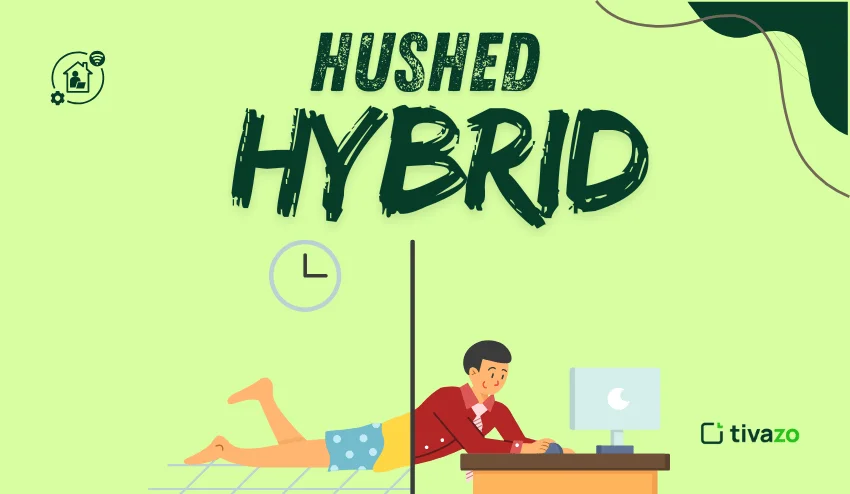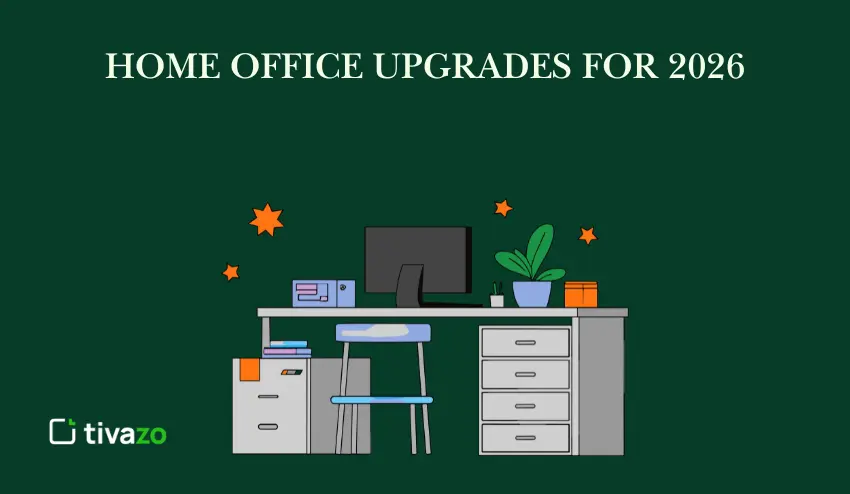The work environment has evolved considerably in the past few years. During conversations about the return to work – remote or otherwise – there has been a subtle trend that has emerged: the quiet hybrid. Managers are tolerating remote working despite their policies that require everyone to be back in the office.
In this article, we will explore what the hidden hybrid is, why it is developing, and what opportunities and challenges it presents for organizations’ workplaces. As this hidden transformation grows, it is changing how leaders think about flexibility, trust, and productivity. Understanding this hidden hybrid will be critical in successfully navigating the future of hybrid
What is Hushed Hybrid Work?
Hushed hybrid denotes an informal, even tacit arrangement, within an organization involving managers and employees that diverges from the formal policies, visiting the office presence (or even formal re-entry) without significantly rejecting (or denying) the established model of hybrid work.
Hushed hybrid might look like:
A manager routinely utilizes a team member’s “remote work” status, or allows a colleague to overnight a “very work” remote work change, even though on the surface it violates established norms for in-office engagement.
Employee is engaging in “coffee badging,” going to the office only to briefly show their face to provide some measure of in-person presence, rationalize their in-office attendance, or fulfill attendance metrics; otherwise, work remotely.
The department has signed off on circumventing established norms when productivity doesn’t suffer.
Hushed hybrid is quite different from hybrid work. HAW is the formal, documented, procedural, standardized, and organizationally enforced use of hybrid work. Hushed hybrid lives in those gray places, open-ended, discretionary, and often away from the senior operations leadership or HR.
What is Hybrid Working in the Workplace?
To comprehend the concept of hushed hybrid, it is first necessary to define hybrid working and what that looks like in any modern organization.
Here is the definition broken out for clarity:
1. Definition
Hybrid working is a way of working where employees spend time working remotely (at home or some other location) and then on-site (in the office) at the work location, so there is a combination of both remote and on-site work.
2. Structure and clarity
Hybrid working is a formal arrangement with clear guidelines and expectations. Oftentimes, companies will define:
- Some days each week are to be in the office.
- One or two days for collaborative work or meetings.
- More generally, certain roles can work flexibly and remotely based on role or purpose.
3. Purpose
The hybrid model is designed to create a balance between flexibility and collaboration, enabling teams to have autonomy but remain connected to the society of the organization
4. Key benefits of hybrid working:
- Work-life balance is improved for our employees.
- Reduced stressors from commuting because of a combination of working from home and being on-site.
- The ability to focus and be more productive while working away from the office.
- The ability to work together as a team easily and efficiently while on-site.
- Improved employee satisfaction and retention.
5. When teams are on-site
On-site office time is often simply for purposes of:
- Collaboration, brainstorming, or team building
- Meeting with employees from other departments or internal collaboration
- Meeting with clients or others to collaborate creatively, etc
6. Difference between Two Models
- Hybrid working → Formal and transparent, and structured hybrid working model combining remote + onsite work, in the workplace.
- Hushed hybrid → An informal practice that is under-the-radar, resulting in an ability to work flexibly without being called out with the presence of official office-required days.
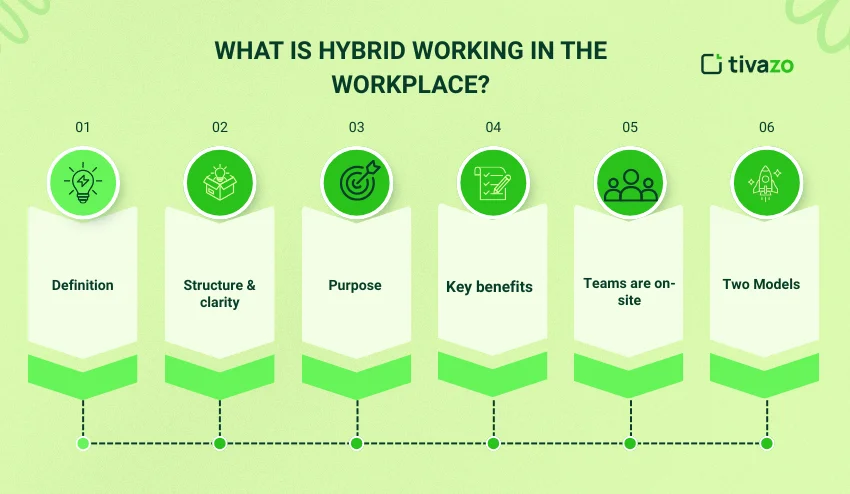
The hybrid model is not going anywhere
It is evolving. Hybrid work is not diminishing; instead, it is becoming more fluid, negotiated, and outcomes-based. Organizations and workers are redefining expectations of work, merging flexible working arrangements with collaboration.
Here are some highlights of the trends and factors leading to this evolution:
| Trend / Factor | Description | Impact on Hybrid Work |
| Return-to-Office Mandates | In some industries, return-to-office expectations are strict, but at other organizations, we are observing the mandates to have no impact at all; the hybrid behaviors are being practiced quietly and above the required expectations. | Policies cause erratic compliance, while real practices highlight the gap between the practice and policy. |
| Employee Expectations | Trust, autonomy, and flexibility are increasing employee expectations. When organizations are given a choice, rigid return-to-office models often backfire. | Managers will embrace flexible conversations quietly if they are losing talent. |
| Results-Only Work Environments | Organizations are more focused on output versus in-office presence. | Employees will be evaluated on productivity, which promotes hybrid flexible working. |
| Hushed Hybrid Behavior | Employees and their managers quietly evade policy mandates to accommodate remote working arrangements. | Policies will need to evolve to acknowledge everyday practice and align with organizational policy. |
| Policy Evolution | Organizations are changing hybrid working frameworks, making them flexible and adaptable. | Obscures the lines between formal and informal work models; it highlights the emphasis on outcome-based organizational culture. |
| Future Intent | Hybrid working will not go away – it will continue in some version, while it will take on new structures and purpose, utilizing clear communication and trust. | Organizations are asked to balance flexibility, productivity, and trust while still ensuring and promoting employee engagement. |
To summarize, hybrid work is not going away! Rather, it is evolving into a hybrid of formal policy and informal, quiet hybrid practices. Organizations that embrace this evolution with open, flexible frameworks will be able to retain talent, enhance productivity, and grow a better workplace culture in the years ahead.
Is Hybrid Working on the Decline in 2025?
While the hybrid model isn’t going anywhere, hybrid work is transforming. Instead of disappearing, hybrid work is likely to become even more fluid, negotiated, and flexible in scope and outcomes.
Several indicators support this evolution
- Return-to-work (RWD) mandates are tightening in some sectors and in others are only mildly enforced, or literally “sneaked around” in hushed hybrid work, by employees.
- Employee demands increasingly wiggle towards trust, autonomy, and flexibility. Forcing an employee into a rigid return-to-office model often backfires.
- Organizations are experimenting with “results-only work environments” (measuring output rather than merely ‘being there ’).
- The existence of a hushed hybrid culture itself indicates that the current RWD or hybrid polices fit what employees do as it relates to attendance to the office, meaning they won’t be able to impose compliance to a more rigid hybrid model.
- Hybrid work will be around; only the divide between informal and formal hybrid policies will be even further divided, and therefore, collaborative frameworks for transparent, iterated policies will be more important than ever.
5 Reasons Hushed Hybrid is Happening
Let’s examine the reasons Hushed Hybrid is happening. The following core drivers help explain this clandestine phenomenon.
Post-Pandemic Flexibility Expectations
Employees experienced the newfound benefits of remote work: less time commuting, more work-life balance, and autonomy. Many now perceive flexibility as non-negotiable, which has led both managers and employees to secretly break the rules.
1. Post-Pandemic Flexibility Expectations
Employees experienced the newfound benefits of remote work: less time commuting, more work-life balance, and autonomy. Many now perceive flexibility as non-negotiable, which has led both managers and employees to secretly break the rules.
2. Managerial Pragmatism & Empathy
Middle managers experience the push-pull of wanting to comply with senior leadership’s directive to come to the office while facing resistance from employees working with each other to defy the rigid expectations. In order to safeguard employee morale and retain top talent, some managers might rationalize quietly allowing flexibility.
3. Discrepancy Between Policy and Reality
Many formal policies were developed without any regard for individual needs (commutes, personal situations, and role-specific flexibility requirements). Hushed hybrid occurs in the gray area when the return-to-work policy diverges from ‘lived’ realities.
4. Talent Retention Necessity
In recent competitive labor markets, providing flexibility is a significant differentiator. Organizations run the risk of losing qualified employees if they insist on rigid and unreasonably strict policies. Some managers subtly shift towards using a hushed hybrid to limit turnover and preserve their top performers.
5. Emphasis on Outcomes over Presence
Many leaders are becoming increasingly focused on deliverables and not face time. If work is getting accomplished in an efficient manner remotely, insisting that employees return and work in person is counterproductive. This subtle shift in thinking is part of the hushed hybrid movement.
These motivations provide fertile ground for hushed hybrid to thrive, especially in localized environments where oversight is decentralized and trust levels are high.
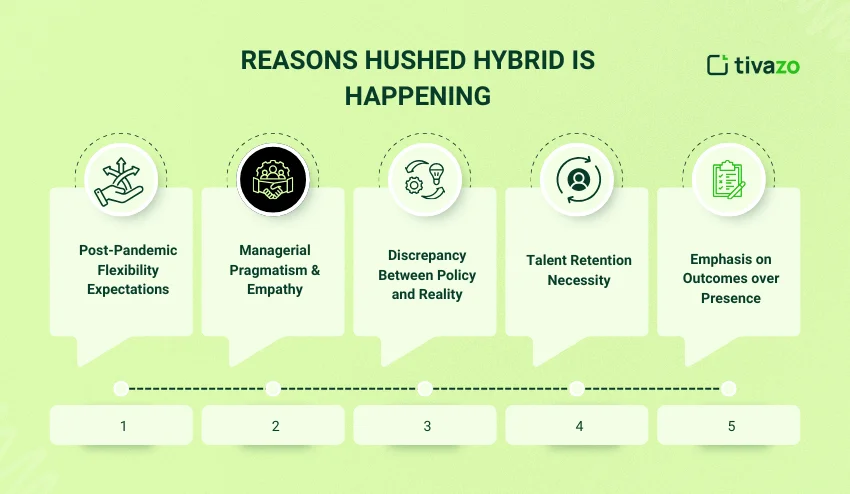
The opportunities & challenges of hushed hybrid
The opportunities of hushed hybrid
For organizations that are willing to work with the nuances of a hushed hybrid, there are many potential benefits to it.
1. Increasing Trust & Employee Independence
Allowing for subtle flexibility is a sign of trust. Employees who are trusted will often reciprocate through increased engagement and accountability.
2. Attracting & Retaining Talent
Flexibility is still the top criterion for job seekers. Hushed hybrids can be a retention lever when the corporate office is not meeting employee needs or expectations with formal policies.
3. Cost & Resource Efficiency
Having a lower office presence may help or allow, to some extent, reduce utility costs, real estate, facility costs, or even repurpose office space.
4. Greater Focus and Deep Work
Remote environments can often lead to fewer interruptions and more focused time, which leads to deeper work and greater productivity.
5. Policy Adaptation Agility
Because a hushed hybrid is not formal, teams may have time to experiment with hybrid patterns that can collect data and insight before formality is imposed through policy.
Challenges (Drawbacks) of Hushed Hybrid
Hushed hybrid also has some potential risks and challenges:
1. Lack of Transparency & Perceived Inequity
If flexibility applies unequally, employees can start to feel images of bias and inequity, potentially damaging trust.
2. Decreased Credibility of Policies
If leaders set strict RTO rules but managers understand the rules, the credibility of the company strategy is enhanced, as well as the plan being cohesive.
3. Inconsistent Implementation
Ultimately, without anyone monitoring this hybrid model, some teams may adhere to the hybrid work model and others may not, causing disorganization in culture and operations.
4. Difficulties in Performance Judgments
Disparate hybrid practices make evaluating one team’s performance difficult to compare to others.
5. Chance of Backlash or the Retreat of Policy
If your employees find out about the hidden practices, it may lead to clashes among employees, demands to formalize work, or to refrain from upper leadership from implementing policies in a more stringent sense.
5 Benefits of Hushed Hybrid for Organizations
To summarize, the following describes 5 benefits of an organization embracing or tolerating to some degree:
- Boost Morale and Loyalty: Employees respond positively to flexibility and trust, leading to stewardship and higher retention.
- Competitive Profitability: Organizations are perceived as flexible profitability in the employment market.
- Cost Savings: Less physical environment leads to utility savings, the cost of real estate, and other overhead.
- Innovative Culture: Flexibility in employing self-directed employment and schedules fosters creativity and the finding of new ideas.
- Incremental Change Pathway: Hushed hybrid gives teams an opportunity to experiment with hybrid flexibility in micro-settings before the formal adoption, reducing risk.
5 Disadvantages of Hushed Hybrid for Organizations
On the flip side, the 5 disadvantages are:
- Damage to Trust & Fairness: When some individuals benefit and others don’t, resentment is built.
- Policy Discrepancy: Publicly stipulated policies by leadership may differ from private actions, creating distrust
- Inconsistent Culture: Silos of informal flexibility can disrupt the company’s identity and collective norms.
- Evaluation Challenges: Performance metrics may not account for equity between remote and in-office, ultimately skewing assessments.
- Reactive Backlash: Finding out that hush hybrid behavior exists may lead to more strict mandates or pushback internally.
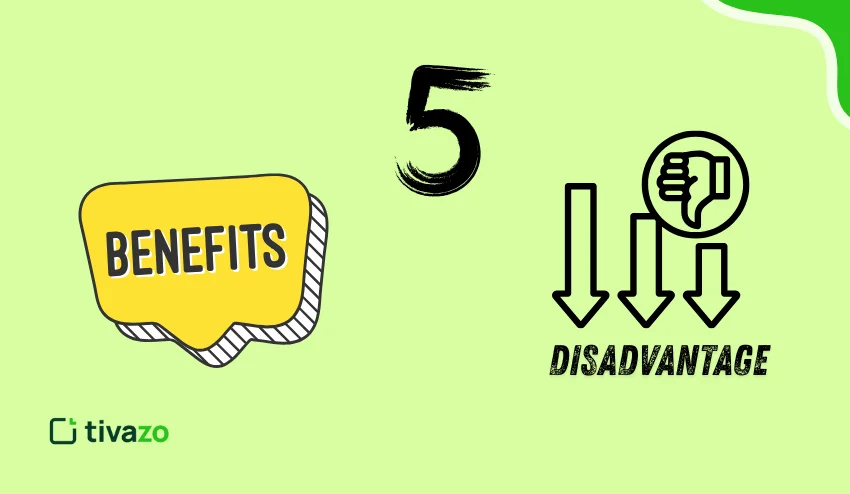
The Future of Hushed Hybrid Work
What will a hushed hybrid look like in 2025 and beyond?
1. Making Hybrid Flexibility More Formal
Many organizations will push scare hybrid to a place of formal, transparent hybrid or “flexible hybrid” approaches that align with reality.
2. Outcome-Based Models
Work models that are assessed by final output results, rather than presence, have the potential to rise in use as policing is not a necessity.
3. Hybrid Policy Wrappers & Analytics
So many tools now exist to track occupancy, performance, and attendance to give organizations a way to track and calibrate hybrid behaviours.
4. Cultural Expectations
Instead of the residual strain of hushed hybrid work, companies will foster trust, equity, and clear and open communication as tenets of hybrid norms.
5. Role-Based Flexibility
Not all positions warrant in-person work; therefore, the use of hybrid/hushed hybrid will be more specific to roles, versus a blanket expectation.
6. Regulatory & Compliance Parameters
As hybrid norms develop, the trajectory of pocket terms may collide with employment laws, and workers may experience greater scrutiny from employers.
In summary, the existence of hushed hybrid will lessen as organizations implement and maintain more explicit flexibility, but the nuances will determine how hybrid norms develop.
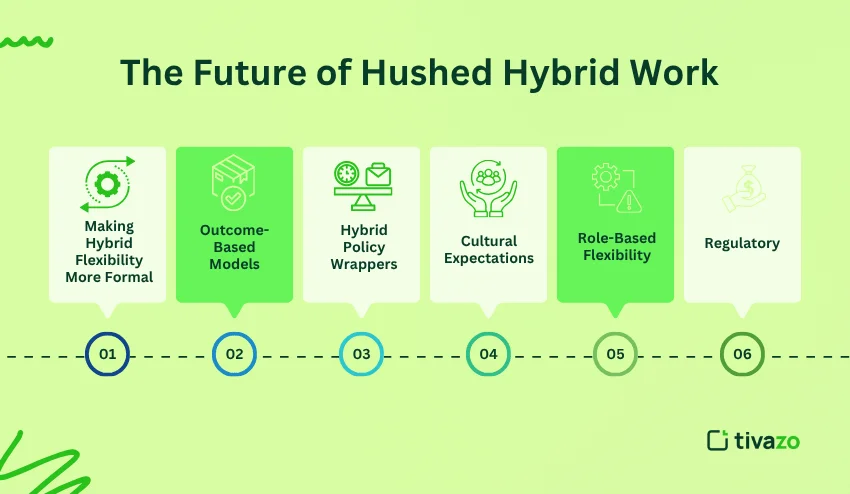
Conclusion
Hushed hybrid is an informal and implicit practice that is changing the modern workplace by combining both formal hybrid policy and informal flexibility for employees. Traditional hybrid working follows a consistent structure of expectations for both in-office and remote working hours, whereas hushed hybrid allows employees and managers to adjust or bend single policies for improved productivity and work-life balance. The unnamed benefits consist of increased trust and autonomy by managers and employees, as well as savings in costs associated with work and transportation. But hushed hybrid work also generates inconsistencies, concerns about fairness and equity, and may conflict with existing workplace policies.
So hybrid work is not going away, but rather, it’s evolving into a much more fluid, outcome-based model. Consequently, organizations that develop more open, adaptable policies as to the ‘real’ work that employees engage in will help foster this new evolution in the world of work.
